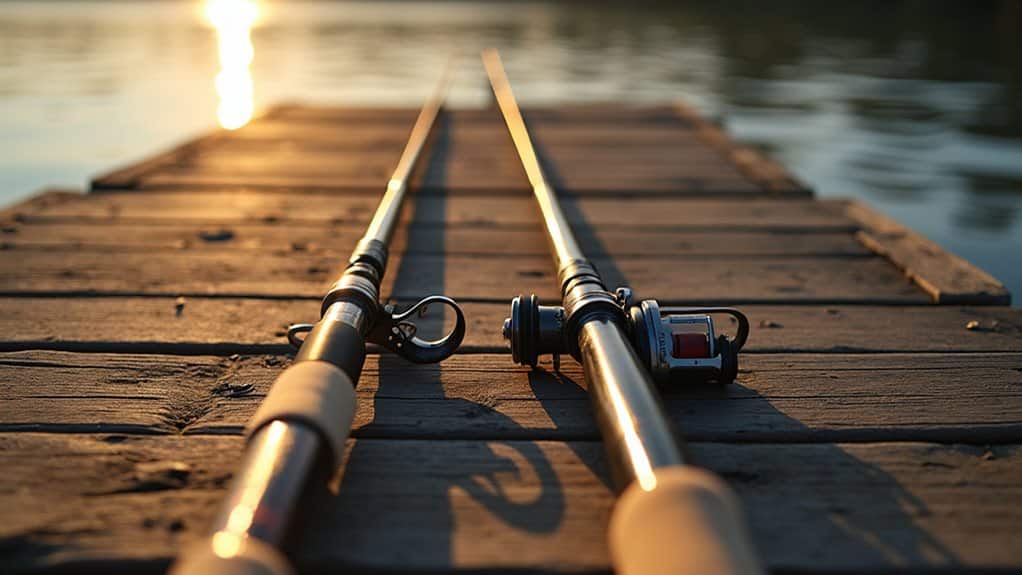A fishing rod’s action describes how it bends under pressure and where the bend occurs along the blank. Fast-action rods bend primarily at the tip, making them ideal for quick hook sets and feeling strikes. Moderate-action rods flex further down the blank, offering more forgiveness for reaction baits. Slow-action rods bend throughout their entire length, perfect for lighter lures. Understanding your rod’s action will help you choose the right tool for your target species and fishing style.
TLDR
- Rod action refers to how much a fishing rod bends under pressure and where along its length the bending occurs.
- Fast-action rods bend primarily at the tip, while slow-action rods flex throughout their entire length.
- The action affects casting distance, hook-setting speed, and how well you can feel fish strikes.
- Fast-action rods provide better sensitivity and quick hook sets, while moderate-action rods offer more forgiveness for certain lures.
- Choosing the right rod action depends on your target species, fishing technique, and the type of lures you use.
Understanding Rod Action: From Fast to Slow

When you’re choosing a fishing rod, understanding its action is essential for matching your gear to your fishing style and target species.
A rod’s action refers to how it bends under pressure, ranging from extra-fast to slow. Fast-action rods flex mainly at the tip for quick hook sets, while moderate-action rods bend further down, and slow-action rods flex throughout their entire length. The speed at which a rod returns to its normal position after bending varies by action type, with fast actions returning more quickly to their original state. Additionally, understanding hook choice is crucial, as it complements the rod’s action for effectively targeting catfish.
The Science Behind Fishing Rod Flexibility
Behind every successful cast lies a fascinating interplay of physical forces that make fishing rods both powerful and precise tools.
When you cast, your rod bends and stores energy like a spring, which it then releases to propel your lure forward. This flexibility comes from advanced materials like carbon fiber, which provides an ideal strength-to-weight ratio while efficiently spreading bending stresses throughout the rod’s length. The rod’s design maximizes your casting power by functioning as a mechanical lever arm, translating your motion into greater force. Additionally, the sonar technology in modern fish finders enhances the fishing experience by helping anglers locate fish more efficiently.
Matching Rod Action to Your Fishing Style

Selecting the right rod action can make the difference between landing your dream catch and telling another story about the one that got away.
If you’re primarily fishing with single-hook lures like jigs and worms, you’ll want an extra-fast action rod for maximum sensitivity.
For crankbaits and reaction baits, choose a moderate action that offers more forgiveness during retrieval. Additionally, consider how bait colors impact your choice of rod action, as they can enhance visibility and effectiveness in different fishing conditions.
How Rod Action Affects Lure Performance
Understanding rod action can dramatically enhance your lure’s performance on the water.
A fast-action rod helps you cast farther and set hooks quickly with jigs and worms, while offering superior sensitivity for feeling strikes.
You’ll find moderate-action rods excel with crankbaits and spinnerbaits, as they absorb sudden movements and provide better control during straight retrieves. Additionally, the competitive nature of fishing often depends on the specific techniques and equipment used, making rod action a crucial factor in tournament success.
Selecting the Perfect Action for Target Species

While lure performance relies heavily on rod action, the species you’re targeting should ultimately guide your choice of fishing rod.
For bass fishing, you’ll want fast to extra-fast action rods to enhance sensitivity with single hooks.
Trout anglers should opt for slow to moderate actions that work well with lighter lures, while pike fishing demands medium to heavy power with fast actions for handling larger baits.
Final Note
Choosing the right rod action is essential for your fishing success. Whether you’re casting light lures with a fast-action rod or working heavy baits with a moderate setup, you’ll need to match your rod’s action to your technique and target species. Remember, there’s no “perfect” action for every situation – it’s about finding what works best for your specific fishing needs and personal style.




